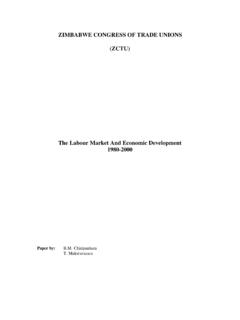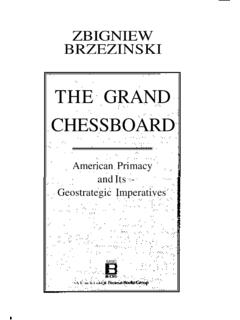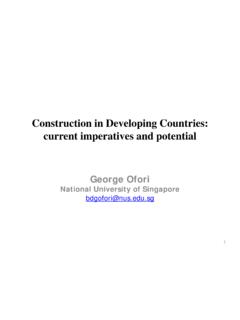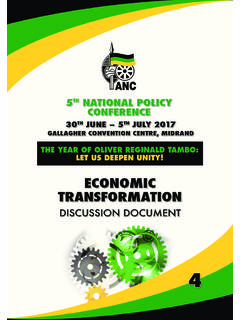Transcription of An analysis of the Soviet economic growth from …
1 An analysis of the Soviet economic growth from the 1950's to the collapse of USSR*. (Second draft). Numa Mazat Numa Mazat**. Franklin Serrano**. Abstract: The purpose of this paper is to study the Soviet economic growth from 1950. to 1991, focusing on the questions of capital accumulation and structural change. The period will be divided into three phases, corresponding to different levels of economic growth and structural features. The first phase, from the 1950s to the beginning of 1970s, corresponds to a regime of extensive accumulation of capital with fast growth of output and per capita GDP. The next phase, from the 1970s to the Mid-1980s, corresponds to a period of economic slowdown, with an attempt to move to a regime of intensive accumulation. The third and last phase began in 1985 with the Perestroika reforms.
2 It is characterized by poor economic performance and the dismantlement of the Soviet economic System. Kalecki's contribution to the study of socialist economics is used, along with elements of the structuralist tradition and the modern classical approach. I. Introduction Before the First World War, Russia was an under-developed and industrializing country. In the words of Spulber (2006, p. 152): notwithstanding [ ] the attempts at partial industrialization, by the beginning of the twentieth century, Russia was still a backward, agrarian, semi-feudal country . In the early 1920's, after the First World War, the 1917's Revolution and the Civil War, USSR has lost part of his limited capacity production and still remains an essentially rural country1. In a context of *. The authors would like to thank, but by no means implicate, profs.
3 Carlos Medeiros (IE/UFRJ) and Carlos Pinkusfeld (IE/UFRJ) for useful discussion about the topic. **. Professor, Institute of Economics, Universidade Federal do Rio de Janeiro (UFRJ), Brazil. 1. In 1926, only 17,9% of the Soviet population lived in towns (DYKER, p. 3). 1. international unanimous hostility, USSR economic recovery and industrialization was a necessary condition to survive, but, could be financed externally by foreign credit and investment only to a minor extent. Despite this difficult situation, Soviet economic mobilization and the adoption of a planned command economic model, in almost autarkic conditions, proved to be successful and USSR became an industrialized power before the end of the 1930's. The purpose of this paper is to study the Soviet economic growth from 1950 to 1991, focusing on the questions of capital accumulation and structural change.
4 Kalecki's contribution to the study of socialist economics is used, along with elements of the structuralist tradition and the modern classical approach. The evolution of the Soviet economy from 1950 to 1991 can be divided into three phases, corresponding to different levels of economic growth (see table 1) and structural features. The first phase, from the 1950s to the beginning of 1970s, corresponds to a regime of extensive accumulation of capital with fast growth of output and per capita GDP. The next phase, from the 1970s to the Mid-1980s, corresponds to a period of economic slowdown, with an attempt to move to a regime of intensive accumulation. The third and last phase began in 1985 with the Perestroika reforms. It is characterized by poor economic performance and the dismantlement of the Soviet economic System.
5 The paper is organized as follows. Section II deals briefly with the main characteristics of the Soviet economic system. Section III examines the determinants of high growth rates observed in USSR from the 1950s to the beginning of 1970s. Section IV discusses the reasons of the slowdown of economic growth from the 1970s to the Mid-1980s. Section V is focused on the analysis of the consequences of Perestroika and Glasnost reforms on the Soviet economic system, ultimately provoking its collapse. Section VI offers brief final remarks. II. Main features of the Soviet economic system The USSR was a planned command economy, which operated under conditions of capital scarcity, with state ownership of the means of production. Production was 2. directed towards use and not towards sale and profit. Full employment of labor was constitutionally guaranteed.
6 The state had the monopoly of foreign trade. Central planning allocated resources for the entire production process. In the USSR, economic activity was defined and subordinated to the instructions from above. The plan was imperative. As Stalin (in ELLMAN, 1979, p. 17) put it: plans are not forecasts but instructions . In both its design and implementation stages, central planning is based on a hierarchical pattern of national economy, which in turn presupposes obedience and discipline (KOWALIK, 1987, ). The central planning organ in the Soviet Union was the Gosplan (State Planning Commission). The Gosplan was in charge of the elaboration of the production plans. Thus, the pricing system was administered and the Gosplan defined goals of physical production for the whole economy. As pointed out by Kalecki (1966 [1993]).
7 And Nell (1997), consumption of the workers was the adjustment variable between aggregate supply and aggregate demand, through forced savings. The production potential was limited by the stock of fixed capital, and its actual degree of utilization could be held low by a scarcity of circulating capital inputs or workforce (FEL'DMAN, 1928 [1964]; KALECKI, 1966 [1993], 1970 [1993]). The Soviet economy, as a socialist economy, was resource constrained', with utilization parameters of resources determined [ ] by the supply side (KORNAI, 1979). The minimization of the costs and the increase of efficiency were not priorities. There was no problem of effective demand in the Soviet Economy, on the contrary to capitalist economy. As stated by Kalecki (1970 [1993], p. 113), in socialist economies [ ] the problem of effective demand is really solved [ ]: prices are fixed by planning authorities in relation to wages in such a way as to achieve full utilization of resources (and this is true not only in the long run but even in a short period).
8 The priorities of the Soviet system, at least until the end of the 1960's, were in order: 1) economic growth thanks to investment 2) Military spending 3) Level of personal consumption of subsistence (food, clothing, housing). 3. 4) Public consumption (spending on health, education, other social and cultural services). So, diversification of consumption patterns (including consumer durables) was not considered a top priority before the 1970s. As a command economy, USSR was characterized by a resource mobilization towards rapid industrialization (GROSSMAN, 1987). In the Soviet economic system, a priority was given to the allocation of investments to producer goods industries rather than consumer goods ones. This strategy was very clear as far back as the First Five Year Plan (1928-1933). Feldman (1964 [1928], p.
9 194), one of the leading Soviet economists of the 1920's stated that an increase in the rate of growth of income demands industrialization, heavy industry, machine building, electrification . The emphasis on heavy industry rather than light industry can be explained by the importance of the Soviet military-industrial complex. As Clarke (2007, ) argues: the Soviet system [ ] was a system of surplus appropriation and redistribution subordinated to the material needs of the state and [ ] of its military apparatus. [ ]The development of the system was not subordinated to the expansion of the gross or net product in the abstract [ ] but to expanding the production of specific materials and equipment tanks, guns, aircraft, explosives, missiles . and to supporting the huge military machine.. The Soviet economy was heavily militarized because the country was constantly confronted with the hostility of the other foreign powers and especially the United States (and also China after 1960)2.
10 This militarization of the economy had strong structural implications. The entire production of key sectors was controlled by the VPK, the Soviet military-industrial commission. Thus, most technological innovations and scientific breakthroughs were generally first allocated to military uses. Many industries were designed to be able to switch from civilian activity to the production of military equipment in a short notice. Similarly, many products such as transportation equipment (aircraft, trucks) had to be of dual use (both military and civilian). The geographic dispersion of industrial complexes was decided for strategic not economic reasons. The existence of large stocks of inventories was also necessary in this context of a "permanent war economy". 2. In Gerschenkron's words: there is very little doubt that [ ] Russian industrialization in the Soviet period was a function of country's foreign and military policies (GERSCHENKRON, 1962, p.)






